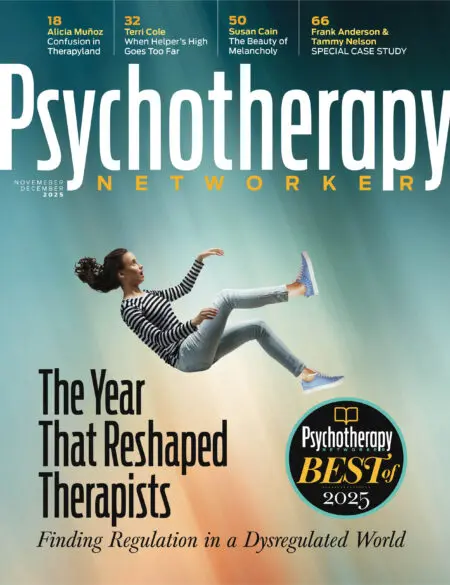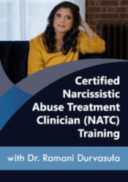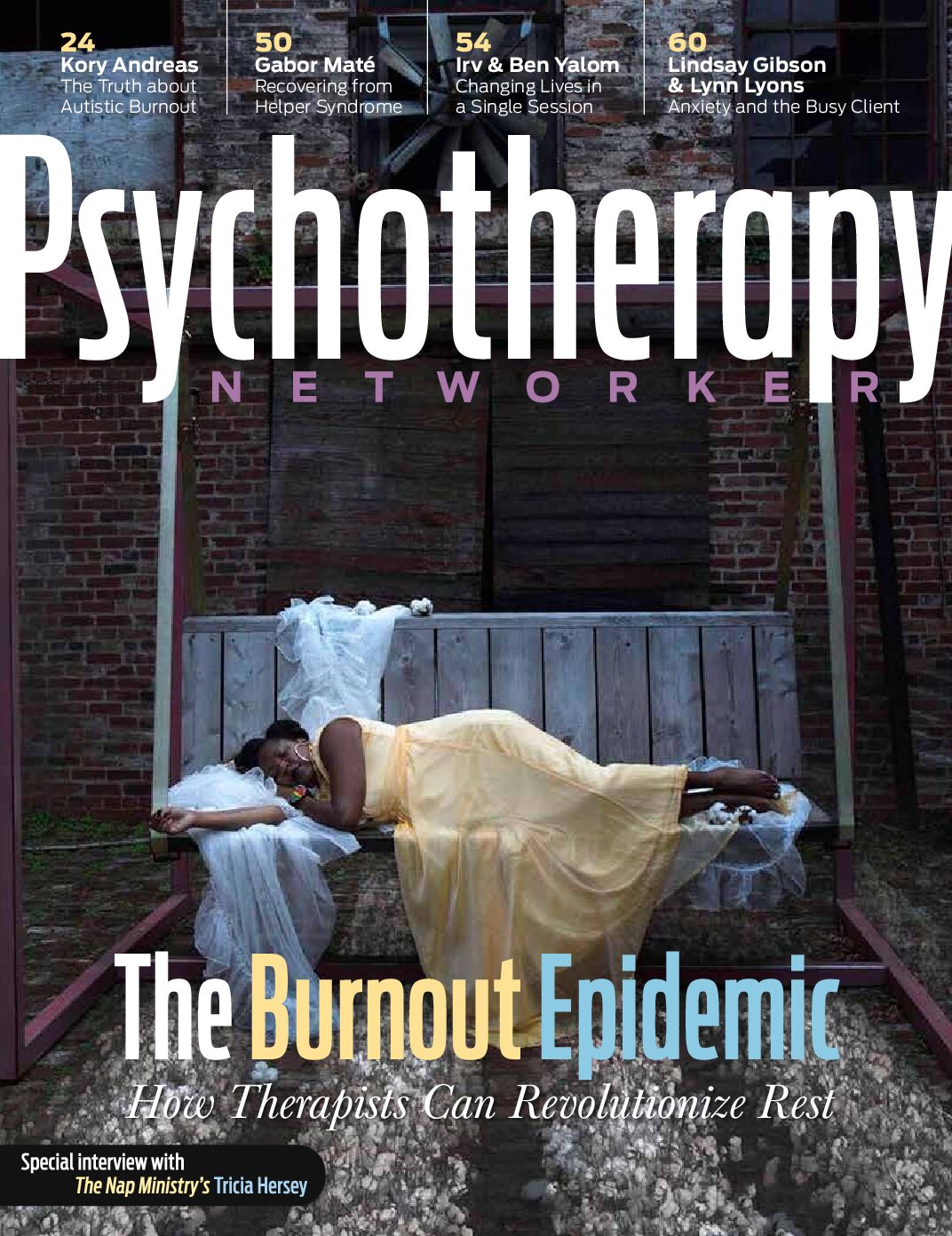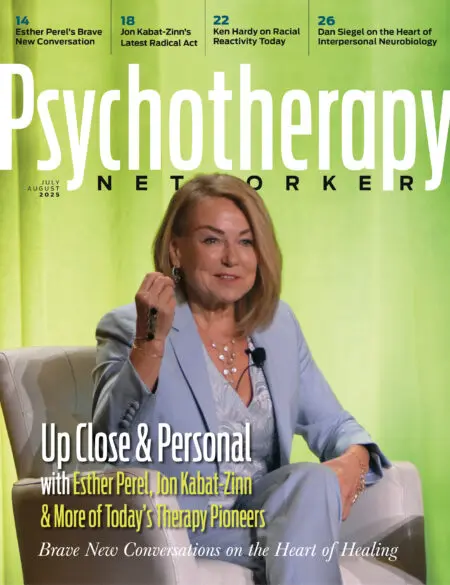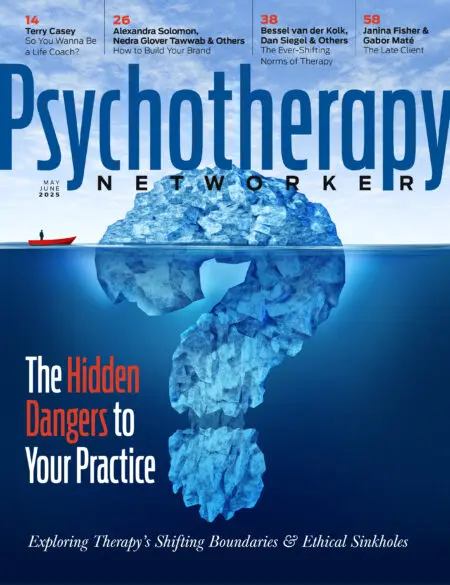Several years ago, Maryanne, a new client, came to see me after she’d moved from a small town in the Midwest to Washington, DC, where I work as an EMDR therapist. For eight years before the move, she’d been the sole caretaker of her mother, who’d had Alzheimer’s disease. By the time her mother had died, Maryanne, a nurse, was so burned out that she’d decided to start over by taking a policy job in a new city.
When I met her, she said was feeling lonely, but noted that this wasn’t a new feeling for her: she’d been carrying around a deep sense of aloneness for most her life. She’d heard that EMDR worked faster than traditional therapy and was hoping it would help allay this feeling of isolation, so she could move through her current depression and start making friends.
At the time, I’d been practicing EMDR for about 10 years and teaching for Francine Shapiro, the developer of EMDR. I knew the model, protocol, and procedural steps inside and out. I was confident that I could help Maryanne, but I recognized that her depression wasn’t only about what had happened in her life—it was also about what hadn’t happened. During her childhood, she hadn’t received the love and attention she’d needed to feel secure and connected in the world, and healing her attachment wounds was going to take longer than the few weeks or months it usually takes to treat a PTSD episode.
When EMDR was first developed, it gained notoriety as a brief, evidence-based treatment for PTSD. For that reason, emphasis has always been on the fidelity to the model and its procedural steps, so it can be more widely accepted in professional and academic circles. As an unintended consequence, EMDR therapists have undervalued the client–therapist relationship in favor of adhering to the protocol.
There’s often an overfocus on the cognitive-behavioral elements of the model and an underfocus on its psychodynamic and client-centered elements. Before I was trained in EMDR, I was trained as a psychotherapist, and I learned to work within the therapeutic alliance. My psychotherapy training emphasized that the client–therapist relationship informs our goals, process, and, of course, the emotional bond that creates the safe space that makes it possible for our clients to “go there.”
I met Maryanne in the early days of what I now refer to as Relational EMDR Therapy, a modality I developed as an adaptation to the standard approach, because I was working with clients who were suffering from attachment trauma. They needed more of a secure attachment experience with their therapist as part of their healing journey, rather than what the standard EMDR protocol offered. While establishing rapport with a client is important in any modality, it’s often a means to an end. But in Relational EMDR Therapy, it’s part of the work itself, right alongside the reprocessing of memories and their associations. As we build the relationship in real time, we can repair any ruptures that occur, offering clients new, adaptive memories of feeling seen, heard, and understood, sometimes for the first time in their lives.
As a Relational EMDR therapist, I’m always tracking what it’s like for clients to be relating their story to me. So, while asking questions about their problem, when their symptoms began, and what was happening in their lives around that time, I’m also inviting them to reflect on what it’s like in the moment. Especially in those early conversations, I’m assessing the effects of their experiences on their current relationship with themselves, as well as with others.
Some clients’ traumas are primarily about external events; for many others, the trauma is developmental, meaning it’s about being hurt by people they love, usually by members of their family. Often, their symptoms are like a low-grade fever that’s been with them throughout their lives. They’ll say things like, “I’ve always been this way,” or “I’ve been in therapy for years, but nothing has worked.”
It’s true that clients need an empathic presence, but some clients need the relational component of an attuned therapist more than others. This doesn’t mean I ditch the EMDR protocol. It means that instead of just taking a client’s history, for example, I’ll periodically stop to ask, “What are you noticing now?” or, “As you’re telling me about this, what’s it like for you?” Such questions make our conversation less about the story and more about the client’s experience of telling it.
The Attuned Therapist
As I listened to Maryanne, I recognized that a past–present collision was taking over her experience of her present-day life. After several months of not being able to acclimate to her new environment in DC, sometimes spending days in bed, even when on her antidepressants, she realized that her depression wasn’t just about being alone in a new place: it was also about old stuff.
She was surrounded by people at work but felt alone in the same way she had when growing up with an alcoholic father and a mother who were preoccupied with their failing marriage. No one had ever made her feel special or important. She once told me a story about running away from home and hiding under the porch while watching as her mother and father carried on with their day for hours, not even noticing she was gone.
I started therapy with Maryanne as any EMDR therapist might, working with foundational memories that were similar in one or more ways to the current situation. For Maryanne, this was being a young girl in the hospital getting her tonsils out, feeling scared and alone because her parents weren’t there. As she focused on that memory while following a streaming light bar with her eyes—moving her gaze from one side to the other, stimulating the bilateral eye movement that’s at the core of EMDR—I started to notice her feeling very far away from me.
“What are you noticing now?” I asked after each set of eye movements.
“Not much,” she replied.
“When you bring to mind the memory of being alone in the hospital as a kid, does it feel any differently to you now than it did when we started?” I asked.
“Not really,” she replied.
I’d done all the things we teach our trainees: change the direction of the eye movements, change the speed, add an additional form of stimulation, but to no avail. I wondered if she was dissociative, or if a part of her wasn’t quite on board with going into this unchartered emotional territory. Then I wondered if there was something happening between the two of us that might be inadvertently paralleling Maryanne’s early experiences. I was administering this procedure by the book, and I was well practiced at it, and yet it wasn’t working. Suddenly, it occurred to me that I was administering the procedure. Maryanne was in the room with me, but she likely felt as alone as she had in that hospital as a girl.
I decided to experiment with how I could use my therapeutic presence while following the standard EMDR protocols. First, instead of using the light bar, I applied the bilateral stimulation the old-fashioned way, with my fingers. That required me to sit closer to Maryanne, which felt more intimate. After each set, she’d look in my direction, so she clearly welcomed my physical proximity. It felt as if she noticed that I was attending to her, as she could track my verbal and nonverbal interest in her experience through my validating gestures, like my nodding and saying things back to her such as, “That makes sense.” I also periodically asked her, “What’s it like to share this with me right now?” By asking her that metaprocessing question, I was helping her attend to the relational component of her experience as it was happening, so she’d notice she wasn’t alone in this experience: I was with her and connected to her.
After that seminal session, I made a conscious decision to be more actively relational in my work with Maryanne, both verbally and nonverbally. It was always with a light touch, especially during reprocessing sessions, so there could be resolution to the memory work. We stayed focused on the trauma reprocessing, but at the same time we toggled in and out of the shared experience we were both having about what was coming up for her. Sometimes, I was so moved by her experience that I’d share my internal response by saying, “I’m so sorry this happened to you,” further validating her experience and making her reflect on a shared moment of meeting. At the time, very few EMDR therapists were working with developmental trauma, and even fewer would experiment with the protocol.
The Relational Way
Once I became more relational in our EMDR work, not only did Maryanne describe her experience in greater detail, but she was also able to experience certain emotions about her childhood for the first time. She could feel sad for her child self, who’d been so scared and alone and had had no one to talk to about it. She could feel the difference between her depression now, which was the cumulative impact of feeling so alone in her childhood, and the sadness that came from recognizing that she’d been so alone as a child. With some coaching, she was learning to lean into her emotions as she was having them, rather than moving away from them as she always had.
The relational way I worked with Maryanne wasn’t novel, but I hoped that by weaving it into the EMDR protocol, I could help her not only heal old attachment wounds, but also develop the capacity to be in a secure attachment relationship. I learned from her, and other clients like her, that being an expert in your method, be it EMDR or anything else, is only one part of our work. The other part of it is how we show up as an interested, attentive, empathic other, who creates the conditions that make it possible for clients to do what they haven’t been able to do on their own.
After a lifetime of never being in a significant relationship with anyone other than her mother, Maryanne is now happily married and a stepmom to two adult children. On my end, as a therapist and trainer, I’ve come to appreciate that our models of therapy are only as effective as our ability to be flexible and to adapt to our clients’ needs. It’s not just about our clients’ readiness to do the work: it’s also about our readiness and capacity to be with them, moment to moment, aware of our own attachment style and how that informs the way we show up in our role as therapists. Creating that heart connection to our clients makes it a healing journey, and it’s why most of us got into this profession in the first place. We’re relational. So are our clients.
Photo by Polina Tankilevitch/Pexels
Deany Laliotis
Deany Laliotis, LICSW, is a trainer, clinical consultant, and practitioner of EMDR. She’s the director of training for EMDR Institute, Inc., and is the codirector of EMDR of Greater Washington.
